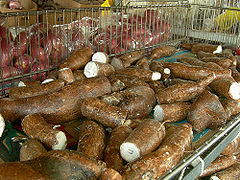Cassava
| Infobox on Cassava | |
|---|---|
| Example of Cassava |  |
| Freshness facts | |
| Optimum carrying temperature | 0°C to +5°C |
| Highest freezing point | - |
| Acceptable product temp. at loading into containers | Max. 2°C above carrying temperature |
| Optimum humidity | 85%-90% |
| Ventilation setting for containers | 15 m³/hr |
| Storage life | 5-6 months (see text) |
| Climacteric / non-climacteric | Non-climacteric |
| Ethylene production | Very low |
| Ethylene sensitivity | Low |
| Modified / controlled atmosphere | - |
| Potential benefits | - |
| Availability | |
| On demand | |
Cassava
Contents
Harvesting and Handling
Fresh cassava roots are highly perishable under ambient conditions, becoming unmarketable in 3 days or less. However, with proper handling, fresh roots can be stored up to 30 days, permitting export by marine container. The roots should be firm, turgid, fairly straight, and free from mechanical injury, decay, and vascular streaking (i.e. internal blue-black vein discoloration). The pulp of most common cultivars varies from white to yellow. Principle causes for loss are vascular streaking and decay. Extended storage can have two adverse effects on quality: starches are converted to sugars and roots become fibrous, lengthening cooking time. Cassava roots are turgid at harvest and must be handled carefully to avoid splitting.
Varietal differences, climatic conditions, and mechanical damage during harvesting all affect the deterioration process and storage capacity of cassava roots. Fresh cassava roots are easily bruised and, when bruised, turn greyish. Therefore, careful handling is necessary.
Cooling and Storage
Cassava is very sensitive to water loss, and methods used to maintain high RH during storage include moist sawdust and plastic films. Waxing and holding at 0°C to 5°C extends shipping time to >30 days with minimal occurrence of vascular streaking.
When adequately dried, cassava will usually keep for 3 to 6 months unless insect infestation becomes excessive. Cassava is chilling sensitive, but it can be stored at 0°C to 5°C with minimal symptom development.
Controlled atmosphere considerations
No commercial-scale recommendations have been reported.
Storage disorders
Aspergillus rot, Botryodiplodia rot, Fusarium rot, Bacterial soft rot, Mucor rot, Phytophthora rot, Rhizopus rot, Sclerotium rot and Trichoderma rot.











